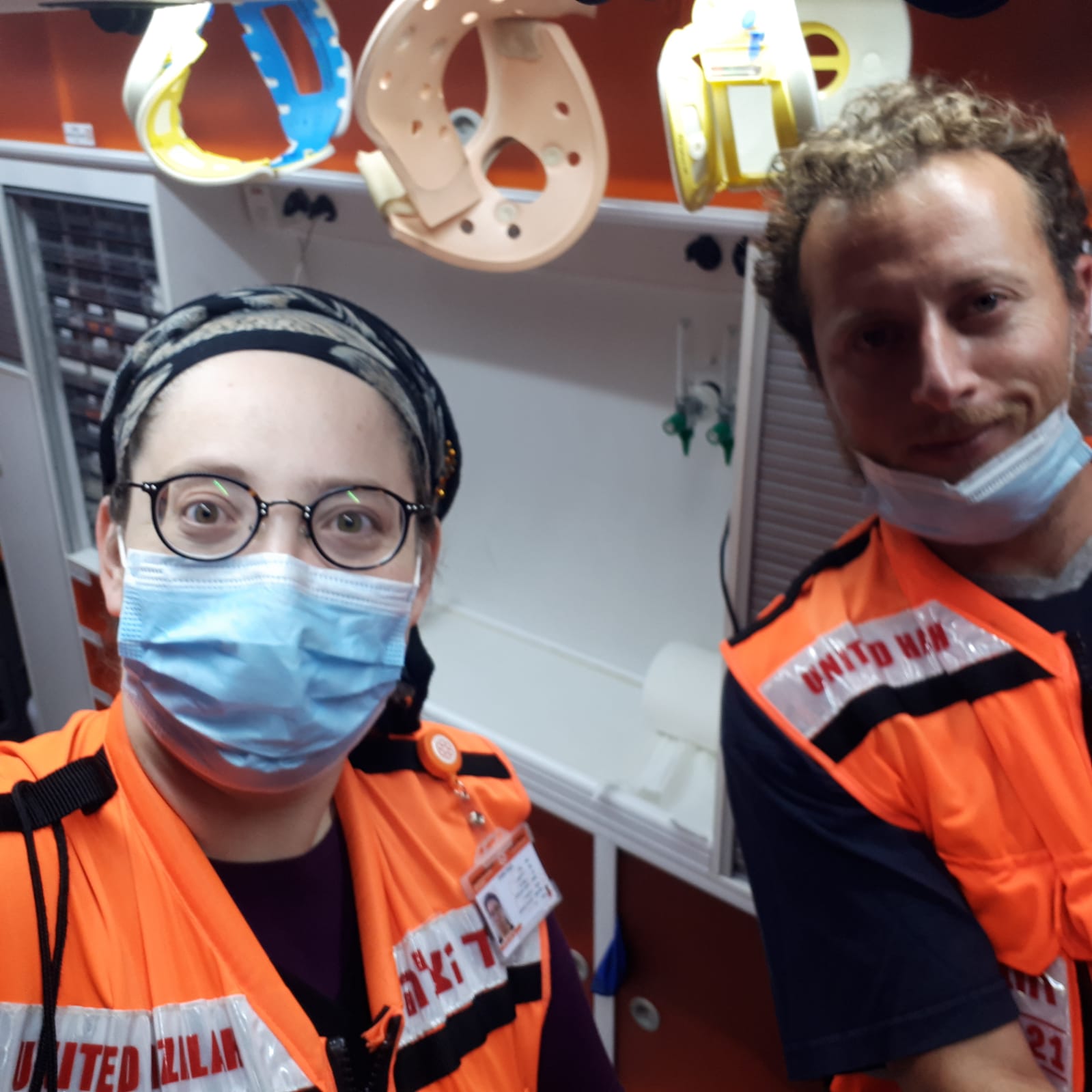
Kalanit on an ambulance shift with EMT Rotem Be’eri
Kalanit Taub – Speak Up. You May Just Save A Life
United Hatzalah, Israel’s largest all-volunteer emergency medical service organization, always responds as quickly as possible to any call for medical assistance. The various EMTs are spread across the country, each living and responding in their own neighborhood. When they receive an emergency alert, they get in their private car or emergency vehicle if they have one, and rush to provide assistance.
In some neighborhoods, navigating the streets can be difficult and traffic can be bad. This is one of the reasons why UH implemented the use of ambucycles. These bright orange hybrids of a motorcycle and an ambulance weave through narrow streets or heavy traffic and allow volunteer EMT’s and paramedics to respond faster. Another positive benefit is that they identify a first responder to pedestrians and passersby letting them know that a qualified emergency medical responder is nearby. It often happens that people will approach an ambucyclist and simply tell them about an emergency that they just witnessed.
A fellow EMT and ambucyclist, was riding his bright orange motorcycle down the busy Jerusalem streets on an unseasonably hot day As he was stopped at a traffic light, a pedestrian approached him and told him about a man nearby who may require assistance. According to the good samaritan, the man in question was walking erratically, completely oblivious to what was going on around him. He repeatedly fell on his face, unable to keep his balance.
The ambucyclist radioed dispatch and requested backup and that an ambulance be sent for this man. As the closest EMT to the scene other than the ambucyclist, I was the first to arrive.
Our patient walked quickly and despite our efforts to calm him, refused to stay in one place. As he walked, we witnessed him fall repeatedly, continuing to injure himself.
The man was covered in dirt and had sustained a large laceration on his face that was covered in dried blood. Additionally, he seemed to be oblivious to the fact his pants had fallen down making it even more difficult for him to walk. He refused treatment in spite of our efforts to communicate with him and treat him each time that he fell.
Whenever we tried to explain to him why he needed help, it seemed that he was unable to comprehend what we were saying. In spite of our efforts, he continuously got up and attempted to walk further only to fall once again and injure himself further.
Finally, he lay down on the sidewalk, apparently completely spent. It appeared that he had no more energy to continue moving. The ambulance that had been following was finally able to stop and the crew took out the stretcher ready to collect and transport the patient.
We began a quick field assessment. While half his face was covered in blood, none of the cuts were actively bleeding, thus, they were not of immediate concern.
We attempted to check if his pupils were reactive to lights, but due to the extreme sunlight that late afternoon, our patient, lying on the ground, refused to open his eyes. The man’s blood sugar was within a normal range canceling out the fear that he was hypoglycemic. We put the man on the stretcher next to us and moved him to the ambulance to begin transport to the hospital and continue to check his vital signs inside the ambulance and out of the heat.
Later that evening, while responding to a different call, I met the same ambulance crew again.
They told me that our patient had crashed on the five-minute drive to the hospital. The ambulance team managed to revive the patient. The staff at the emergency room intubated and sedated the man who was put in the ICU in critical condition. But he was alive thanks to a concerned citizen and the hard work of the medical teams involved.
People might not be willing to call emergency services for a guy stumbling down the street, especially when they appear intoxicated. Heatstroke, however, can appear like intoxication to the inexperienced eye.
I don’t know how my patient is doing now but I can easily picture an alternative scenario, one in which he continued to stumble down the street as people shied away from him assuming he was drunk. The scenario continues as the man finally collapses on the sidewalk with no one around to help until someone would call emergency services. In this case, he probably would have crashed before the ambulance or emergency services even arrived and the likelihood of his survival would have been far worse.
Thanks to the concerned passerby who recognized the ambucyclist on his bright orange United Hatzalah ambucycle and spoke up, the patient was able to receive more immediate care and survived.







